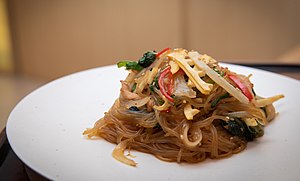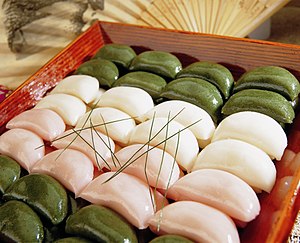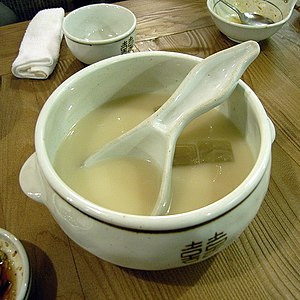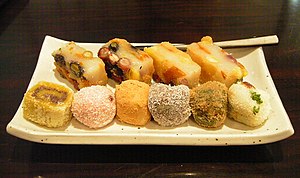Korean cuisine/ja: Difference between revisions
Created page with "==宮廷料理{{Anchor|Royal court cuisine}}== {{main/ja|Korean royal court cuisine/ja}} {{see also/ja|List of Korean dishes#Royal court dishes/ja}} thumb|[[:en:Silla|新羅王国の都慶州にある雁鴨池。]] 前近代において「宮中飲食」と総称されていた王宮の食料は、朝鮮半島の過去の支配者の豪華絢爛な性質を反映していた。この性..." |
|||
| Line 292: | Line 292: | ||
[[:en:Choseon dynasty|朝鮮時代]]に確立された飲酒作法『[[:en:Hyang Eum Ju Rye|郷飲酒礼]]』({{Korean|hangul=향음주례|hanja=鄕飮酒禮|labels=no}})によれば、君主と臣下、父と子、または師と生徒が顔を向き合わせて酒を飲むことは無作法であるとされている。また、客は主人から最初に勧められた酒を断ってはいけないが、最も正式な状況では、食事者は年長の男性または主人から勧められた酒を丁重に2度断るべきである。主人が3度目に勧めた場合に初めて、客はそれを受け取ることができる。客が3度断った場合、それ以上酒を勧めてはならない。 | [[:en:Choseon dynasty|朝鮮時代]]に確立された飲酒作法『[[:en:Hyang Eum Ju Rye|郷飲酒礼]]』({{Korean|hangul=향음주례|hanja=鄕飮酒禮|labels=no}})によれば、君主と臣下、父と子、または師と生徒が顔を向き合わせて酒を飲むことは無作法であるとされている。また、客は主人から最初に勧められた酒を断ってはいけないが、最も正式な状況では、食事者は年長の男性または主人から勧められた酒を丁重に2度断るべきである。主人が3度目に勧めた場合に初めて、客はそれを受け取ることができる。客が3度断った場合、それ以上酒を勧めてはならない。 | ||
==宮廷料理{{Anchor|Royal court cuisine}}== | |||
==Royal court cuisine== | {{main/ja|Korean royal court cuisine/ja}} | ||
{{main|Korean royal court cuisine}} | {{see also/ja|List of Korean dishes#Royal court dishes/ja}} | ||
{{see also|List of Korean dishes#Royal court dishes}} | [[File:Anapji Pond-Gyeongju-Korea-2006-09.jpg|thumb|[[:en:Silla|新羅王国]]の都[[:en:Gyeongju|慶州]]にある[[:en:Anapji Lake|雁鴨池]]。]] | ||
[[File:Anapji Pond-Gyeongju-Korea-2006-09.jpg|thumb|[[ | 前近代において「宮中飲食」と総称されていた王宮の食料は、朝鮮半島の過去の支配者の豪華絢爛な性質を反映していた。この性質は、[[:en:Silla|新羅]]王国時代にまで遡る例に見られる。そこでは、豪華な[[:en:banquet|宴会]]という唯一の目的のために、複数の東屋と広間を備えた人工湖([[:en:Gyeongju|慶州]]にある[[:en:Anapji Lake|雁鴨池]])が造られ、詩を書いている間にワインカップを浮かべるという唯一の目的のために、泉の水を引いた水路である[[:en:Poseokjeong|鮑石亭]]が造られた。 | ||
<div lang="en" dir="ltr" class="mw-content-ltr"> | <div lang="en" dir="ltr" class="mw-content-ltr"> | ||
Revision as of 09:23, 19 June 2025




| この記事は、下記のシリーズの一部です |
| 韓国料理 한국 요리 조선 료리 |
|---|
 |
 |
| Culture of Korea |
|---|
| Society |
| Arts and literature |
| Other |
| Symbols |
|
韓国料理とは、朝鮮の文化に関連する食べ物と料理様式一式である。この料理は、何世紀にもわたる社会的・政治的変化を通じて発展してきた。朝鮮と南満洲における古代の農耕と遊牧の伝統に起源を発する朝鮮料理は、自然環境と異なる文化的傾向との複雑な相互作用を反映している。
韓国料理は主に米、野菜、魚介類、そして(少なくとも韓国では)肉に基づいている。乳製品は伝統的な韓国の食事にはほとんど含まれていない。伝統的な韓国の食事は、蒸して炊いた短粒米に添えられるおかず(반찬; 飯饌; banchan)の数によって名付けられる。キムチはほとんど毎食供される。一般的に使われる材料には、ごま油、テンジャン(発酵味噌)、韓国醤油、塩、ニンニク、ショウガ、唐辛子粉(唐辛子フレーク)、コチュジャン(発酵赤唐辛子ペースト)、白菜などがある。
材料と料理は地方によって異なる。多くの郷土料理が全国的になっている。朝鮮王宮料理は、かつてすべての独自な地域の特産品を王族のために集めた。料理は韓国の文化的なエチケットによって規制されている。
キムジャンは、キムチを作る過程を指し、ユネスコ無形文化遺産に登録されている。
歴史
先史時代
Vf. 櫛目文土器時代(紀元前約8000年~紀元前1500年)には、狩猟採集社会が漁業や狩猟を行い、後期には初期の農業が行われた。無文土器時代(紀元前1500年)の初めからは、遼河流域の満州からの新しい移住者グループとともに農業の伝統が発展し始めた。無文時代には、人々はアワ、オオムギ、コムギ、豆類、米を栽培し、狩猟と漁業を続けた。考古学的遺物はこの時代に発酵豆が発展したことを示しており、北方の遊牧文化との文化的な接触が動物の家畜化を促進した。
三国時代

三国時代(紀元前57年~紀元668年)は、文化が急速に進化を遂げた時代であった。高句麗(紀元前37年~紀元668年)は、朝鮮半島の北部、現在の満州の大部分に位置していた。第二の王国である百済(紀元前18年~紀元660年)は半島の南西部に、第三の王国である新羅(紀元前57年~紀元935年)は半島の南東部に位置していた。各地域には、それぞれ独自の文化慣習と食料があった。例えば、百済は冷たい食べ物や『キムチ』のような発酵食品で知られていた。紀元4世紀の中国との文化交流を通じた仏教と儒教の普及は、韓国の異なる文化を変え始めた。
最古のキムチとされる高句麗の人々は、発酵食品に長け、発酵食品を広く消費していた。
高麗時代

高麗後期には、13世紀にモンゴル人が高麗に侵攻した。現在韓国で見られる伝統的な食品の一部は、この時代に起源を持つ。マンドゥ(餃子料理)、焼肉料理、麺料理、そして黒胡椒のような調味料の使用はすべて、この時代にルーツを持つ。
李氏朝鮮時代
この時代には、15世紀の雨量計の発明など、農業技術革新が著しく広範にわたった。1429年には、政府が農業や農耕技術に関する書籍の出版を開始し、その中には世宗大王の命により編纂された農書である『農事直説』(文字通り「農業に関する率直な話」)も含まれていた。
李氏朝鮮前半期の一連の侵略は、後半期の文化に劇的な変化をもたらした。『実学』(「実践的な学問」)の学者グループは、農業システムを改善するために、革新と技術を国外に求めることの重要性を強調し始めた。新世界からヨーロッパ人によって取引された作物が、中国、日本、ヨーロッパ、フィリピンとの貿易を通じて現れ始め、これらの作物にはトウモロコシ、サツマイモ、唐辛子、トマト、ピーナッツ、カボチャなどが含まれた。ジャガイモやサツマイモは、これまで利用されていなかった土壌や地形でも育つため、特に好まれた。
政府は技術と低税率を通じて農業をさらに発展させた。政府が建設した複雑な灌漑システムにより、農民はより多くの作物を生産し、生計のためだけでなく換金作物としても作物を生産できるようになった。農民への減税も、通常5日ごとに開催される定期市を増やすことで商業の拡大を促進した。19世紀にはそのような市場が千か所存在し、経済取引と娯楽のための共同体の中心であった。
李氏朝鮮時代の終わりは、西洋世界、中国、日本との貿易を一貫して奨励したことで特徴づけられる。1860年代には、日本政府が推進した貿易協定により、李氏朝鮮王朝は西洋との貿易港を開放し、米国、英国、フランス、その他の西洋諸国と多数の条約を締結した。
西洋世界への朝鮮の開放は、文化と食料のさらなる交換をもたらした。西洋の宣教師たちは新しい食材と料理を朝鮮に導入した。李氏朝鮮のエリートたちは、顧問や医師として王宮に出入りしていた外国人を通じて、これらの新しい食品に触れるようになった。この時代には、西洋の商人を通じて日本から輸入された様々な調味料や、中国からのアルコール飲料も導入された。
植民地時代から現代へ


日本は1910年から1945年まで朝鮮半島を占領した。日本の食料供給を支えるため、多くの農業システムが日本に引き継がれた。日本統治による土地の変化には、小規模農場を大規模農場に統合することが含まれ、これにより収穫量が増加した。この期間中、大日本帝国の戦争努力を支援するために米の生産が増加した。その結果、多くの朝鮮人は自らの消費のために他の穀物の生産を増やした。
日本統治時代の食事は非常に多様であった。朝鮮人は通常、寒い季節には1日2食、暖かい季節には3食摂っていた。下層階級にとっては、質よりも満腹感が最も重要であった。さらに低い経済レベルの人々は、毎年一年に一度しか白い米を食べる機会がなかった一方で、残りの年の食事はアワや大麦のような安価な穀物で構成されていた。統治時代の中流階級および上流階級の朝鮮人にとっては、状況はかなり異なっていた。白いパンや、あらかじめ調理された麺のような市販の主食など、西洋の食品が朝鮮の食事に登場し始めた。日本統治時代は、第二次世界大戦での日本の敗北後に終わった。
国は朝鮮戦争(1950年〜1953年)と冷戦を通じて混乱状態にあり、国は北朝鮮と韓国に分断された。これらの両期間を通じて、朝鮮人への食料供給は限られたままであり、ソーセージやスパムのような安価な肉を使った『プデチゲ』と呼ばれるシチューは、この時期に生まれた。
この時点から、北朝鮮と韓国の歴史は大きく分岐した。1960年代には朴正熙大統領の下で工業化が始まり、韓国は今日のグローバル経済における経済的・文化的力を得るようになった。商業肥料や近代的な農機具の使用により農業生産が増加した。1970年代には食料不足が緩和され始めた。インスタント食品や加工食品の消費が増加し、食品全体の質も向上した。1970年代には、商業酪農場と機械化された農場の増加により、家畜と乳製品の生産が増加した。1970年代には豚肉と牛肉の消費が大幅に増加した。一人当たりの肉消費量は1961年には3.6kgであったが、1979年には11kgに達した。この肉消費量の増加は『プルコギ』レストランの隆盛をもたらし、韓国の中流階級が定期的に肉を楽しむことができるようになった。肉食は増加し続け、1997年には40kgに達し、魚の消費量は1998年には49.5kgであった。米の消費量はこれらの年を通じて継続的に減少し、1985年には一人当たり128kgであったが、1995年には106kg、2003年には83kgとなった。米の消費量の減少は、パンや麺の消費量の増加を伴っている。2009年には、韓国政府は韓国料理を宣伝するため、「Korean Cuisine to the World」と呼ばれる7700万ドルの料理外交プログラムを開始し、その後、米国およびイスラム諸国の市場に転換した。
食材
穀物

穀物は、韓国の食生活において最も重要な主食の一つである。韓国における様々な王国の建国神話は、穀物を中心に語られている。ある建国神話は朱蒙に関するもので、高句麗を建国した後、母親が送った2羽のハトから大麦の種を受け取ったとされている。また別の神話では、済州島の3人の創始神が耽羅の3人の王女と結婚することになり、神々が5種類の穀物の種を持参し、それが最初に植えられた種となり、これが農業の最初の例となったと語られている。
先史時代には、大麦やアワといった穀物が主な主食であった。これらは小麦、ソルガム、ソバで補完されていた。米は韓国原産の作物ではなく、米が栽培されるようになる前はアワが好まれた穀物であった可能性が高い。米は三国時代、特に朝鮮半島の南部地域にある新羅と百済王国で選好される穀物となった。米は新羅において非常に重要な商品であり、税金として支払われていたほどである。漢語で「税金」を意味する単語は、稲を表す漢字を用いた複合文字である。米の嗜好は李氏朝鮮時代にエスカレートし、新しい栽培方法と新しい品種が登場し、生産量の増加に貢献した。
米が初めて朝鮮半島にもたらされたとき、非常に高価であったため、他の穀物と混ぜて「水増し」されていたと考えられる。この習慣は、現在でも「ポリパプ」(大麦入りご飯)や「コンパプ」(豆入りご飯)といった料理に残っている。糠を取り除いた白米は、朝鮮料理に導入されて以来、好まれる形態である。 最も伝統的な米の炊飯方法は、「ソッ」(솥)または「ムソエソッ」(무쇠솥)と呼ばれる鉄鍋で炊くことである。この炊飯方法は少なくとも高麗時代にまで遡り、新羅時代の墓からもこれらの鍋が発見されている。ソッは今日でも、過去数世紀とほとんど同じ方法で使用されている。
米は、伝統的な白米の茶碗以外にも、様々なものに加工されている。一般的には粉に挽かれ、200種類以上ある「トック」と呼ばれる餅の材料となる。また、米は煮込んで粥(「チュク」)や重湯(「ミウム」)にされ、他の穀物、肉、魚介類と混ぜて食される。韓国では、濾過したものと濾過していないものの両方で、数多くの米酒も製造されている。穀物はまた、数世紀にわたってミスやミスガルの製造にも使われてきた。これらは穀物粉から作られる飲料で、食事の補助食品として使われることもある。
果物
多様な温帯気候を擁する朝鮮半島では、多くの栽培種および野生の果実が育つ。様々な品種のナシ、リンゴ、メロン、ベリーなどが夏から秋にかけての代表的な産物である。
豆類

豆類は、韓国の遺跡から発見された最古の豆類が示すように、韓国の歴史と料理において重要な作物であった。慶尚南道晋州の玉坊遺跡の発掘調査では、紀元前1000年~900年頃に大豆が食料作物として栽培されていたことが示されている。大豆は現在でも豆腐に加工され、大豆もやしは野菜としてナムルに炒められ、大豆そのものは調味されて付け合わせとして供される。また、豆乳にも加工され、「コングクス」と呼ばれる麺料理のベースとなる。豆乳製造の副産物である「ビジ」または「コンビジ」は、シチューやおかゆのとろみ付けに使われる。大豆は、「コンパプ」の豆の一つとしても使われ、数種類の豆や他の穀物と一緒に煮込まれる。また、大豆は、テンジャンやチョングクジャンといった味噌類、カンジャンと呼ばれる醤油、コチュジャンと呼ばれる唐辛子味噌など、「醤」と総称される発酵調味料の主要な材料でもある。

ノクドゥ(緑豆)は韓国料理で一般的に使われる。「スクジュナムル」(緑豆もやし)は、湯通しして湯通しし、ごま油、ニンニク、塩で味付けした付け合わせとしてよく供される。挽いたノクドゥは「ノクドゥジュク」と呼ばれる粥にされ、特に病気の患者のために栄養補助食品や消化促進剤として食べられる。人気の軽食である「ビンデトク」(緑豆チヂミ)は、挽いたノクドゥと新鮮なスクジュナムルで作られる。挽いたノクドゥから抽出されたデンプンは、透明なタンミョン(春雨)を作るのに使われる。タンミョンは「チャプチェ」(サラダのような料理)や「スンデ」(豚の血の腸詰め)の主材料であり、スープやシチューの副材料でもある。このデンプンは、「ノクドゥムク」や「ファンポムク」のようなゼリー状の食品を作るのにも使われる。これらの「ムク」は味が薄いため、醤油、ごま油、崩した海苔、または「タンピョンチェ」のような他の調味料で味付けして供される。
アズキの栽培は、咸鏡北道会寧の梧洞里の遺跡の発掘調査(無文土器時代、紀元前約1500年~紀元前300年と推定される)によると、古代にまで遡る。アズキは一般的に、豆と混ぜてご飯と一緒に食べる「パッパプ」として、または「トック」(餅)やパンの具や衣として食べられる。アズキを使った「パッチュク」と呼ばれる粥は、冬の時期によく食べられる。冬至(12月22日)という韓国の伝統的な祝日には、韓国の人々はもち米粉で作った団子「セアルシム」(새알심)が入った「ドンパッチュク」を食べる。古い韓国の伝統では、「パッチュク」は悪霊を追い払う力があると信じられている。
調味料
調味料は、発酵調味料と非発酵調味料に分けられる。発酵調味料には、カンジャン(醤油)、テンジャン(味噌)、コチュジャン(唐辛子味噌)、そして酢が含まれる。非発酵調味料やスパイスには、唐辛子、黒胡椒、ドクダミ、マスタード、チョウセンゴミシ、ニンニク、タマネギ、ショウガ、西洋ネギ、ワケギ(ネギ)などがある。
コチュジャン
コチュジャンは多くの文献に見られる。『Mangi Yoram』、『三国志』、『農家月令歌』、『寄齋雑記』、そして『Hyangyak-jipsongbang』などである。朝鮮王朝時代の1433年頃に書かれた『郷薬集成方』は、コチュジャンについて言及している最も古い文献の一つである。
コチュジャンは、唐辛子粉、大豆粉、米粉を加えて作られる辛い発酵味噌である。通常、ほとんどの料理に加えることができる。コチュジャンは調味料としても、時にはつけだれとしても使われる。
多くのバリエーションは「醤」、つまり発酵味噌から派生している。いくつかのバリエーションには、テンジャン(大豆と塩水)、カンジャン(大豆、水、塩)、チョゴチュジャン(コチュジャンと酢)、そしてチョッカル(他の醤と魚介類の混合物)などがある。
キュウリ、ニンジン、キャベツなどの野菜はコチュジャンをつけだれとして使う。コチュジャンは、韓国式焼肉(豚肉や牛肉を含む)のような食品の一般的な調味料である。コチュジャンと共によく食べられる人気のある軽食の一つはビビンバである。ビビンバには米、ほうれん草、大根、もやしが含まれる。時には牛肉がビビンバに加えられることもある。コチュジャンを含むもう一つの人気料理はトッポッキである。
高麗時代には、コチュジャンは風邪や疲労で病気の人々を回復させる力があると信じられていた。赤唐辛子が肥満と糖尿病に効果があることを示す研究もいくつかある。コチュジャンは、各食事に追加の栄養価を持たせるために、多くの食品に加えられることもある。
肉類
古代、朝鮮半島で得られる肉のほとんどは狩猟や漁業によるものであったと考えられている。古代の記録によれば、家畜の飼育は三国時代に小規模で始まった。この時代、肉は焼いたり、スープやシチューに入れたりして消費されていた。海に近い地域に住む人々は食事をより多くの魚で補うことができたのに対し、内陸に住む人々はより多くの肉を含む食事をしていた。
牛肉

牛肉はすべての肉の中で最も珍重され、牛は韓国の家庭で重要な文化的役割を担っている。牛肉は今日、焼いたり(「クイ」)、スープで煮たりするなど、様々な方法で調理される。牛肉は、魚介類が「オポ」と呼ばれるように、「ポ」の一種である「ユクポ」に乾燥させることもできる。
牛は貴重な役畜であり、しばしば人間の召使いと同等、あるいは場合によっては家族の一員と見なされた。牛はまた、旧正月の最初の「牛の日」に独自の祝日が与えられた。牛の重要性は、朝鮮人が牛肉を豊富に食べていたことを示唆するものではない。牛は重荷を運ぶ動物として評価されており、1頭を屠殺することは土地を耕作する上で深刻な問題を引き起こすからである。このため、豚肉や魚介類がより定期的に消費された。高麗時代の仏教支配層は牛肉の消費を禁じた。モンゴル人は13世紀に牛肉の禁止を解除し、肉牛の生産を促進した。この生産増加は李氏朝鮮時代まで続き、政府は牛肉の量と質の向上を奨励した。20世紀後半になって初めて、牛肉が日常の食卓に上るようになった。
鶏肉
鶏肉は韓国の歴史においてタンパク質として重要な役割を担っており、多くの神話にそれが表れている。ある神話では、慶州の金氏の祖である金閼智の誕生が白い鶏の鳴き声によって告げられたと伝えられている。氏族の祖の誕生が常に超自然的な特質を持つ動物によって告げられることから、この神話は韓国文化における鶏の重要性を示している。鶏肉はしばしば焼かれたり、野菜と一緒に煮込まれたり、スープに入れたりして供される。韓国料理では、砂肝、肝臓、足など、鶏のすべての部位が使われる。夏の暑さ対策として食される薬膳スープ「サムゲタン」には、高麗人参などの材料とともに若い鶏が煮込まれる。鶏の足は「タッパル」(닭발)と呼ばれ、しばしば焼いて辛くてスパイシーなコチュジャンベースのソースをかけ、「アンジュ」、つまりアルコール飲料、特に焼酎の付け合わせとして供される。
豚肉

豚肉もまた、韓国におけるもう一つの重要な陸上動物性タンパク質である。記録によれば、豚肉は牛肉と同様に古代から朝鮮の食生活の一部であった。
豚肉を食べる際には、桔梗(「ドラジ」、도라지)やレンコン(「ヨンヌプリ」、연뿌리)など、いくつかの食品が避けられてきた。これらの組み合わせが下痢を引き起こすと考えられていたためである。豚のすべての部位が韓国料理で使われ、頭、腸、肝臓、腎臓、その他の内臓が含まれる。韓国人はこれらの部位を蒸す、煮込む、茹でる、燻製にするなど、様々な調理法で利用する。特に韓国人は、サムギョプサルと呼ばれる豚バラ肉のグリルを好んで食べる。
魚介類

魚や甲殻類は、朝鮮半島を取り囲む海があるため、韓国料理の主要な一部となっている。12世紀の証拠は、平民が主にエビ、アサリ、カキ、アワビ、ドジョウなどの魚介類を摂取していたことを示している一方、羊や豚は上流階級のために確保されていた。
淡水魚も海水魚も人気があり、生食、焼く、炙る、乾燥させる、またはスープやシチューに入れて供される。一般的な焼き魚には、サバ、タチウオ、イシモチ、ニシンなどがある。小魚、エビ、イカ、軟体動物、その他数え切れないほどの魚介類は、塩漬けにして「チョッカル」として発酵させることができる。魚はまた、丸ごとまたは切り身にしてパンチャンとして焼くこともできる。魚は保存期間を長くし、長距離輸送を可能にするために自然乾燥されることが多い。一般的に乾燥される魚には、イシモチ、カタクチイワシ(「ミョルチ」)、イシモチなどがある。乾燥したカタクチイワシは、昆布とともに、一般的なスープのだしの基礎となる。
甲殻類は様々な調理法で広く食されている。だしの材料として使われたり、コチュジャンと酢を混ぜた「チョゴチュジャン」を添えて生食されたり、数え切れないほどの料理の人気食材として使われたりする。生の牡蠣やその他の魚介類は、風味を向上させ多様にするためにキムチ作りに使われることがある。塩漬けの小エビは、一部のキムチの準備のために「セウジョッ」として知られる調味料として使われる。大きなエビはしばしば「テハクイ」(대하구이)として焼かれたり、乾燥させて野菜と混ぜてご飯と一緒に供されたりする。韓国料理で食べられる軟体動物には、タコ、イカ、スルメイカなどがある。
野菜

韓国料理では多種多様な野菜が使われ、サラダや漬物として生で供されることもあれば、様々なシチュー、炒め物、その他の温かい料理で調理されることもある。一般的に使われる野菜には、韓国大根、白菜、キュウリ、ジャガイモ、サツマイモ、ほうれん草、もやし、ワケギ、ニンニク、唐辛子、海藻、ズッキーニ、キノコ、レンコンなどがある。 「チュイナムル」(例えば「シラヤマギク」)と総称される数種類の山菜は人気の料理であり、ワラビの若芽(「コサリ」)やツルニンジンの根(「ドラジ」)のような他の山菜も季節になると収穫され食される。韓国料理における伝統的な薬草、例えば高麗人参、霊芝、クコの実、トウドジン、トウキなどは、『サムゲタン』のように料理の材料として頻繁に用いられる。
薬膳料理
薬膳料理(「ポヤンシク」)は、特に旧暦で最も暑い30日間を指す「サンボク」と呼ばれる期間に、薬効があるとされる目的で調理され食される多種多様な特殊な食品である。食される温かい食品は、夏の暑さで失われた「気」だけでなく、性的および肉体的なスタミナを回復させると信じられている。一般的に食される「ポヤンシク」には、高麗人参、鶏肉、黒山羊、アワビ、ウナギ、コイ、牛骨スープ、豚の腎臓などがある。
サムゲタン
サムゲタンは、夏の最も暑い日である伏日(복날)に伝統的に食される鶏と高麗人参のスープである。熱いものを熱い気候で食べることを以熱治熱(이열치열)と呼ぶ韓国の習慣があり、これは「熱を熱で制する」という意味である。そのため、サムゲタンは韓国人のお気に入りの精力剤であり、韓国で最も暑い日であるとされる三伏(삼복)の日(初伏(초복)、中伏(중복)、末伏(말복))に食べるのが一般的である。
料理
韓国料理は、「主食」(주식)、「副食」(부식)、そして「後食」(후식)の3つのカテゴリーに大別される。主食は「パッ」(ご飯の茶碗)、『チュク』(粥)、『ククス』(麺)など、穀物から作られる。
多くの韓国のパンチャンは、風味と保存のために発酵を利用しており、その結果、酸味、塩味、辛味が特徴的な味となる。特定の地域は特定の料理と特に関連付けられている(例えば、全州市と『ビビンバ』)が、これは発祥の地であるか、有名な地域品種があるためである。レストランはしばしば、これらの有名な名前を看板やメニューに用いる(例:「水原カルビ」)。
スープとシチュー

スープは韓国の食事には欠かせないもので、他国の文化とは異なり、韓国文化では食事の最初や最後に提供されるのではなく、ご飯や他のパンチャンの付け合わせとしてメインコースの一部として提供される。「クク」として知られるスープは、しばしば肉、魚介類、野菜で作られる。スープは、「タン」として知られるより正式なスープにすることもでき、しばしば食事のメインディッシュとして提供される。「チゲ」は、より濃厚で風味豊かなスープまたはシチューである。
いくつかの一般的なスープの種類は以下の通りである:
- マルグンクク(맑은국)は、カンジャンで味付けされている。少量長く煮込んだ肉が加えられたり、生の魚介類や乾燥魚介類が加えられたり、あるいは野菜が澄んだスープの主成分となったりする場合もある。
- テンジャンククは、テンジャンで味付けされている。トジャンククの一般的な材料には、アサリ、煮干し、エビなどの魚介類が含まれる。より辛いスープには、コチュジャンが加えられる。
- 『トックク』は、薄切りにした餅と牛肉のスープで一般的に作られる餅スープである。白い餅はペクビョン(백병-白餠)またはコム(거모-擧摸)と呼ばれた。トッククは薄切りにしたカレトックで作られる。カレトックは米粉で作られた長く円筒形の餅である。トッククは鶏ガラで煮込まれるが、元々はキジ肉のスープで煮込まれていた。「キジを狩るのは容易ではなく、鶏を飼育しているので、キジの代わりに鶏を使う。鶏がない場合は牛肉さえも使う」(꿩 대신 닭)とある。北朝鮮には、餅を丸い形にしたジョレンイトッククと呼ばれるこのレシピのバリエーションがある。韓国人は旧正月の日にトッククを一杯食べると一年年を取ると信じられているため、この日に食べられる。楕円形の餅は、ヨプチョン(엽전)として知られる昔の韓国の硬貨に似ているため、幸運をもたらすという信仰がある。
- コムククまたはコムタン(곰탕)は、牛骨や軟骨を煮込んで作られる。農民の料理として始まったもので、肉が付いているかどうかにかかわらず、尾、脚、肋骨など、牛肉のすべての部位が使われる。これらは水で煮込まれて脂肪、骨髄、ゼラチンが抽出され、濃厚なスープが作られる。このスープのいくつかのバージョンでは、牛の頭や腸も使われる場合がある。スープに一般的に使われる唯一の調味料は塩である。
- ネンククは、暑い季節に涼を取るために一般的に食べられる冷たいスープである。これらのスープの味付けは通常控えめで、主にカンジャンとごま油が使われる。
- シンソンロ(またはクジャタン)。その名前は、木炭を燃やすための煙突が付いた特別な鍋に由来する。その意味は、常に19種類の具材が入っている炉、かまど、または火や香を焚くための鍋である。19種類の具材には、牛肉、魚、卵、ニンジン、キノコ、タマネギなどが含まれる。
シチューは「チゲ」と呼ばれ、しばしば共有の副菜となる。チゲは、調理された釉薬をかけた土鍋(「トゥッペギ」)の中で調理され、そのまま供されることが多い。このシチューの最も一般的なバージョンは「テンジャンチゲ」で、味噌のシチューであり、多くのバリエーションがある。一般的な材料には、野菜、海水魚または淡水魚、そして豆腐が含まれる。このシチューは、季節や入手可能な材料によって頻繁に変化する。チゲの他の一般的な種類には、キムチ(「キムチチゲ」)や豆腐(「スンドゥブチゲ」)が含まれる。
- 『ミヨックク』。このスープは乾燥海藻から作られる。『朝鮮料理製法』によると、通常はワカメを牛肉と一緒に炒めて水を注ぎ、スープにする。ムール貝を加えるとさらに美味しくなる。また、沿岸地域では牛肉の代わりに魚を使うこともある。このスープは通常、韓国人の誕生日、特にサムチルイル(삼칠일:出産後の新生児のための安静期間)、ペクイル(백일:生後100日目)、トルチャンチ(生後1歳の誕生日)に食される。母親が産後に海藻を食べるという韓国の伝統は、高句麗に由来する。海藻の韓国語「ミヨク」は高句麗に由来する。
キムチ

キムチとは、多くの場合、白菜、大根、または時にはキュウリを使って作られる、しばしば発酵させた野菜料理を指す。主な原材料は、スパイス、調味料、その他の追加材料の4種類がある。赤唐辛子、黒胡椒、シナモン、ニンニク、ショウガ、タマネギ、マスタードなどがスパイスの例である。地域によって無限の種類があり、付け合わせとして、またはスープやご飯料理に調理されて供される。15世紀後半には、発酵食品が数年間保存できることから、韓国の先祖が冬の間ずっとキムチの壺を地中に埋めて保存する習慣が描かれている。これらは伝統的な韓国の土鍋であるチャンドクデに保存されていたが、冷蔵庫の登場、特殊なキムチ用冷凍庫、市販のキムチの普及により、この習慣はあまり一般的ではなくなった。キムチは低カロリー、低脂肪、コレステロールゼロの野菜ベースの食品である。また、様々なビタミンやミネラルの豊富な供給源でもある。ビタミンA、ビタミンB、ビタミンC、ビタミンKなどのビタミンと、カルシウム、鉄、リン、セレンなどのミネラルが含まれている。ヨーグルトや他の発酵乳製品に含まれるのと同じ乳酸菌もキムチに含まれている。2021年、韓国人は collectively で1,965,000トンのキムチを消費し、平均的な韓国人は毎日88.3グラムのキムチを消費している。
麺類

韓国料理における麺または麺料理は、固有語で「ククス」、漢字語で「ミョン」と総称される。麺は古くから韓国で食べられていたが、小麦の生産が他の作物に比べて少なかったため、小麦麺が日常食となるのは1945年以降のことである。小麦麺(「ミルグクス」)は、その長く続く形が長寿や末永い結婚の幸福と結びついていると考えられていたため、誕生日、結婚式、縁起の良い機会などの特別な料理であった。
韓国の伝統的な麺料理には、「オンミョン」または「ククスジャングク」(熱い澄んだスープの麺)、『冷麺』(冷たいそば粉の麺)、『ビビングクス』(野菜と混ぜた冷たい麺料理)、『カルグクス』(手打ち麺)、『コングクス』(冷たい豆乳スープの麺)、『チャプチェ』(サツマイモで作られた春雨と様々な野菜)などがある。宮廷では、そば粉の麺とキジのスープからなる「ペクミョン」(文字通り「白い麺」)が最高級の麺料理とされていた。『冷麺』は、トンチミ(水っぽい大根キムチ)と牛肉の出汁を混ぜた冷たいスープで、夏に宮廷で食べられていた。
- チャジャンミョンは、韓国で非常に人気のある、韓国風中華麺料理であり、手早く持ち帰りできる食品として親しまれている。通常、黒豆ソースを角切り豚肉または**魚介類**、そしてズッキーニやジャガイモなどの様々な野菜と一緒に炒めて作られる。世界の他の地域における中華料理の出前と同様に、出前や持ち帰りでよく注文される。
- ラミョンは、ラーメンに似た韓国のインスタントラーメンを指す。
- チャプチェは、ローストした野菜、キノコ、肉をそれぞれローストし、熱湯に入れた料理である。これは韓国の伝統料理の中で最も人気のある料理の一つで、結婚式、祝日、誕生日などの特別な機会に楽しまれる。チャプチェには、春雨を入れるものと入れないものの2種類がある。朝鮮の料理書『閨門要覧(キュゴンヨラム)』(約1670年)によると、春雨が入っていないレシピのみが記載されている。春雨が入っていないオリジナルのレシピは、キュウリ、マツタケ、豆もやし、キキョウ、青ネギなどの野菜を茹でてから、ショウガ、コショウ、ごま油、小麦粉を振りかけて作られる。ソースは、ひき肉と、ごま油と小麦粉で軽く濾した味噌を煮詰めて作られる。名前の通り、20種類以上の食材が使われていた。1896年の『閨門要覧(キュゴンヨラム)』にも、春雨なしで**マスタードソース**で味付けしたチャプチェが記録されている。しかし、1930年代以降、オリジナルのレシピとともに春雨入りのチャプチェのレシピが登場する。また、朝鮮王朝時代の『朝鮮料理法』にも、春雨入りと春雨なしのチャプチェのレシピが追加された。また、1930年代には、肉入り、アワビ入り、その他の魚介類入りのチャプチェのバリエーションも存在する。これは伝統的なレシピを示す郷土料理である。晋州地域では、「ジャムンサム」、「ヨキムン」は醤油とごま油で味付けし、タコ、エイなどの魚介類と油で汚れた様々な野菜を混ぜた郷土料理である。様々な食材を使うため、高カロリー、高タンパク質、高脂肪、ビタミン、ミネラルを豊富に含み、十分な栄養価がある。これは祝宴のテーブルを飾る際に最初に選ばれる一品である。
パンチャン
パンチャンとは、韓国料理における副菜を総称する言葉である。スープやシチューはパンチャンとは見なされない。

「クイ」はグリル料理を指し、その主な材料はほとんどの場合肉または魚であるが、場合によってはグリル野菜やその他の野菜材料を含むこともある。伝統的なレストランでは、炭火焼きグリルでテーブルの中央で肉が調理され、その周りには様々なパンチャンや個別のご飯茶碗が並べられる。調理された肉は小さく切られ、新鮮なレタスの葉で、ご飯、薄切りニンニク、「サムジャン」(コチュジャンとテンジャンの混合物)、その他の調味料と一緒に包まれる。肉ベースのクイの名前では、しばしば「クイ」という接尾辞が省略される。例えば、「カルビ」は元々「カルビクイ」であった。
「チム」と「ソン」(蒸し料理)は、韓国料理における蒸し料理または煮込み料理を指す総称である。ただし、前者はコチュジャンまたはカンジャンでマリネした肉や魚介類を主材料とするのに対し、「ソン」は具材を詰めた野菜で作られる。
「フェ」(生料理):この用語は元々あらゆる種類の生料理を指していたが、一般的にはセンソンフェ(생선회、刺身)を指すのに使われる。コチュジャン、またはワサビ入り醤油につけて、レタスやエゴマの葉と一緒に供される。

「ジョン」(または「ブチムゲ」)は、様々な材料から作られる韓国の風味豊かなパンケーキである。刻んだキムチや魚介類を小麦粉ベースの衣に混ぜ込み、フライパンで焼く。この料理は通常、醤油、酢、赤唐辛子粉を混ぜたものにつけて食べる。前菜、副菜(「パンチャン」)、または酒の肴(「アンジュ」)として供される。
「ファジョン」(화전)と呼ばれる甘い種類もあり、これは花餅を意味する。
大豆油やコーン油などの食用油が今日使われているが、これらの油を生産するための技術は李氏朝鮮時代には利用できなかった。

「ナムル」は「センチェ」(생채、文字通り「生野菜」)または「スクチェ」(숙채、文字通り「加熱した野菜」)のいずれかを指す場合があるが、一般的には後者を指す。センチェは主に酢、唐辛子粉、塩で味付けされ、酸味とさわやかな味を与える。一方、「スクチェ」(숙채)は湯通しされ、醤油、ごま油、刻んだニンニク、または時には唐辛子粉で味付けされる。
アンジュ(酒の肴)

アンジュは、酒と共に食される韓国の副菜の総称である。焼酎やマッコリといった韓国の伝統的な酒によく合い、人々が酒をより楽しむのに役立つ。アンジュの例としては、コチュジャンを添えたイカの蒸し物、フルーツ盛り合わせ、ドゥブキムチ(豆腐とキムチ)、ピーナッツ、「オデン」/オムク、「ソラ」(소라)(屋台で人気の貝の一種)、テナガダコ(ナクチ)、豚足(チョッパル)などが挙げられる。サムギョプサル(豚バラ肉)も焼酎のアンジュと見なされている。ほとんどの韓国料理はアンジュと見なすことができ、酒と共に食される食べ物は食べる人の好みや嗜好に左右される。
行事食
ソンピョン

『ソンピョン』は、主に秋夕の時期に先祖への感謝の気持ちを表すために食べられる米粉で作られた韓国の料理である。ソンピョンの記録は17世紀から現れる。『要録』には「白米粉で餅を作り、松の葉で蒸し、水で洗い流す」と記されている。ソンピョンの初期には、米粉で餅を作り、松の葉で蒸して水で洗い流すというシンプルなものであった。『婦人必知』には「小豆、松の実、クルミ、ショウガ、シナモン」が加えられたとある。『韓国の餅、韓菓、飲清類』では、「江原道や忠清道などの山間部では、ジャガイモソンピョン、ドングリソンピョン、ソンギソンピョンが作られ食べられてきた。咸鏡道、平安道、京畿道の沿岸部では、貝ソンピョンが作られ食べられ、全羅道や慶尚道の南部地域では、苔の葉を入れたソンピョンが作られ食べられた」と記されている。
オゴクパプ

『オゴクパプ』は五穀ご飯を意味し、米、もち米、コーンスターチ、小豆、エゴマ、大豆を混ぜて作られる。青、赤、黄、白、黒の五色の穀物を食べることで、五行のエネルギーとともに体の健康と良い一年を祈り、厄を払い、幸福と福祉を願う。
飲料
ノンアルコール飲料

韓国の伝統的なノンアルコール飲料はすべて「ウムチョン」または「ウムチョンニュ」(음청류 飮淸類)と呼ばれ、文字通り「澄んだ飲み物」を意味する。ウムチョンニュは、材料と製法によって以下のカテゴリーに分類できる。
韓国料理における茶、または「チャ」は、温かくも冷たくも供される様々な種類のハーブティーを指す。必ずしもチャノキの葉、葉芽、節間とは関連せず、果物(例:『ユジャチャ』)、花(例:『ククファチャ』)、葉、根、穀物(例:『ポリチャ』、『ヒョンミチャ』)や、高麗人参(例:『インサムチャ』)やショウガ(例:『センガンチャ』)などの伝統的な韓国医学で使われるハーブや物質など、多様なものから作られる。
アルコール飲料

焼酎は最もよく知られた酒であるが、韓国ではビール、米酒、果実酒、リキュール、甘い米飲料など、100種類以上のアルコール飲料が生産されている。韓国で最も売れている国産ビール(韓国語で「メクチュ」)はラガービールであり、大麦ではなく米から醸造される点で西洋のビールとは異なる。そのため、韓国のビールは西洋のビールよりも軽く、甘く、泡立ちが少ない。韓国のビール市場は、ハイトとOBの2大醸造所が独占している。テドンガンは、2002年から平壌を拠点とする醸造所で生産されている北朝鮮のビールである。2002年以降、地ビールや地ビールバーの人気が高まっている。
『焼酎』は、元々穀物、特に米から作られ、現在ではサツマイモや大麦からも作られる透明な蒸留酒である。穀物から作られた焼酎は優れているとされている(穀物とジャガイモのウォッカの場合も同様)。焼酎のアルコール度数は約22%で、金欠の大学生、酒豪のビジネスマン、肉体労働者に人気の飲み物である。
『薬酒』は、米を発酵させた洗練された純粋な酒で、最もよく知られているのは清酒である。『濁酒』は、穀物から作られたとろみのある未精製の酒で、最もよく知られているのは『マッコリ』である。マッコリは、農民が伝統的に飲む白くて乳白色の米酒である。
米酒の他に、韓国料理には様々な果実酒や薬草酒が存在する。アカシア、梅、カリン、桜、松の実、ザクロが最も人気がある。『マジュアンワイン』(韓国産ブドウとフランス産またはアメリカ産ワインのブレンド)や高麗人参ベースのワインも入手可能である。
菓子


伝統的な餅『トック』や韓国の菓子『韓菓』は、祝日や祭りの際にご馳走として食べられる。『トック』は、ついた米(메떡, 「メトック」)、ついたもち米(찰떡, 「チャルトック」)、またはつかずにそのままのもち米から作られるあらゆる種類の餅を指す。甘くした緑豆餡、小豆餡、つぶした小豆、レーズン、ごま、甘いカボチャ、豆、ナツメ、松の実、蜂蜜などを詰めるか、表面にまぶして供される。トックは通常、デザートや軽食として供される。種類の中では、『ソンピョン』は秋夕に供されるもちもちした詰め物入りのトックである。蜂蜜や、甘くしたごまや黒豆などの柔らかい甘い材料が詰め物として使われる。松の葉は蒸す過程で風味付けのために使われる。『ヤクシク』はもち米、栗、松の実、ナツメなどの材料で作られた甘い餅で、一方『チャプサルトック』は甘い小豆餡を詰めたトックである。
一方、「韓菓」は、あらゆる種類の韓国の伝統的な菓子を指す総称である。韓菓の材料は主に穀物粉、蜂蜜、『ヨッ』、砂糖、または果物や食用根菜からなる。韓菓は大きく揚げ菓子(ユミルグァ)、『スクシルグァ』、『チョングァ』、『クァピョン』、『茶食』(茶菓子)、そして『ヨッ』に分けられる。ユミルグァは、『メジャクグァ』や『ヤックァ』のように、生地を炒めるか揚げるかして作られる。メジャクグァは、小麦粉、植物油、シナモン、ショウガ汁、『チョチョン』、松の実で作られたリング状の菓子で、一方ヤックァ(文字通り「薬菓子」)は、蜂蜜、ごま油、小麦粉で作られた花形ビスケットである。
『スクシルグァ』は、果物、ショウガ、ナッツを水で煮込み、それを元の果物の形や他の形に成形して作られる。『クァピョン』は、酸味のある果物、でんぷん、砂糖を煮詰めて作られるゼリー状の菓子である。『茶食』は文字通り「茶のための食べ物」を意味し、米粉、蜂蜜、そしてナッツ、ハーブ、ゴマ、ナツメなど様々な種類の粉を練り合わせて作られる。『チョングァ』は、果物、植物の根、種子を蜂蜜、『ムルヨッ』(물엿、水飴)または砂糖で煮詰めて作られる。それはマーマレードやジャム/ゼリーに似ている。『ヨッ』は、蒸した米、もち米、もちアワ、トウモロコシ、サツマイモ、または混合穀物から作られる液体または固形の韓国の伝統的な飴である。蒸した材料は軽く発酵させられ、「ソッ」(솥)と呼ばれる大きな鍋で長時間煮込まれる。
『ユグァ』と『ヤックァ』。これらは秋夕、結婚式、または還暦の際に楽しまれる伝統的なデザートである。
地域および派生料理

韓国の地域料理(향토음식; hyangtoeumsik)は、韓国料理内の郷土色豊かな特産品と独特の様式が特徴である。これらの区分は、現代までこれらの食と料理の伝統が保存されてきた道の歴史的な境界を反映している。
韓国は1948年以来、北朝鮮と韓国という二つの国家に分かれているが、かつては朝鮮王朝の行政区画に従って八道(「パルド」)に分かれていた。北部地域は咸鏡道、平安道、黄海道で構成されていた。中部地域は京畿道、忠清道、江原道で構成されていた。慶尚道と全羅道が南部地域を形成していた。
19世紀後半まで、交通網は十分に発達しておらず、各地方地域は独自の特色ある味覚と調理法を保持していた。地理的な違いは、気候や農業の種類、利用可能な自然食品に応じて、地元の特産食材にも反映されている。現代の交通機関の発達と外国食品の導入により、韓国の地域料理は重複し、統合される傾向にある。しかし、韓国の地域料理には多くのユニークな伝統料理が何世代にもわたって受け継がれてきた。
精進料理

韓国精進料理は、韓国の仏教寺院に起源を持つ。仏教が韓国に伝来して以来、仏教の伝統は韓国料理にも強く影響を与えてきた。新羅時代(紀元前57年~紀元935年)には、「チャルパプ」(찰밥、炊いたもち米の飯)、「ヤックァ」(揚げ菓子)、そして「ユミルグァ」(揚げて膨らませた米菓子)が仏壇に供され、韓国の伝統的な菓子である韓菓の一種として発展した。高麗時代には、「サンチュサム」(レタスで巻いたもの)、「ヤクシク」、そして「ヤックァ」が発展し、その後、中国や他の国々にも広まった。李氏朝鮮時代以降、精進料理は地域や寺院によって韓国で確立された。
一方、韓国の宮廷料理は、韓国の精進料理と密接に関係している。かつて、王の食事を準備する「水剌間」(수라간; 水剌間)に配属された宮女である「尚宮」は、年老いると宮殿を去らなければならなかった。そのため、彼女たちの多くは尼僧になるために仏教寺院に入った。その結果、宮廷料理の調理技術やレシピが精進料理に組み込まれた。
ベジタリアン料理

韓国のベジタリアン料理は、高麗時代以降に韓国文化に影響を与えた仏教の伝統と関連があるかもしれない。韓国には数百軒のベジタリアンレストランがあるが、歴史的には観光客には知られていない地元のレストランであった。ほとんどの店はビュッフェ形式で、冷菜、ベジタリアンキムチ、豆腐が主な特徴である。ビビンバは一般的なビーガン料理である。メニューは季節によって変わる。アルコール抜きのワインや上質な韓国茶も提供される。韓国の茶道はすべてのベジタリアンやビーガンに適しており、仏教の影響を受けて始まった。すべての料理は、ステンレス製の楕円形の箸と「スジョ」と呼ばれる柄の長い浅いスプーンの組み合わせで食べられる。
儀式料理
食べ物は、主に儒教文化に基づいた韓国の家族の儀式の重要な部分である。「冠婚葬祭」(관혼상제; 冠婚喪祭)と呼ばれる四つの家族の儀式(成人式、結婚式、葬儀、祭祀)は、特に重要かつ精巧に発展し、今日まで韓国人の生活に影響を与え続けている。韓国の儀式料理は、地域や文化によって多様に発展してきた。
例えば、「祭祀」と呼ばれる先祖供養の儀式は、主に先祖の命日に執り行われる。儀式料理には、ご飯、餅、肉、魚、酒、果物などが含まれる。
屋台料理


韓国では、日中、屋台(『ポジャンマチャ』)で安価な食べ物が購入できる。客は屋台のそばで立ったまま食べることもできるし、包んでもらって持ち帰ることもできる。夜になると、ポジャンマチャ(포장마차)は食べ物、飲み物、アルコール飲料を売る小さなテントになる。
季節の屋台料理には、秋と冬に楽しまれる『ホットク』や『ブンオッパン』がある。『ケランパン』や『ホッパン』も冬に楽しまれる。
その他の一般的な屋台料理には、『キンパ』(김밥)、『トッポッキ』(떡볶이)、『スンデ』、『トゥギム』、そして『オムク』がある。『タッコチ』(닭꼬치)、つまり様々なソースで焼かれた串刺し鶏肉も人気がある。『ポンデギ』(번데기)と『ダルゴナ』/『ポプギ』(뽑기)は、多くの人々が子供の頃から楽しんできた伝統的な屋台料理の2つの例である。

作法
食事


韓国における食事作法は、朝鮮時代の儒教思想に遡る。李徳懋(이덕무; 李德懋)によって1775年に書かれた『士小節』(『士大夫家族のための初歩的な礼儀作法』)などの教訓書は、当時の食事作法について述べている。 提言には、「太った牛、ヤギ、豚、鶏を見ても、すぐに屠殺したり、料理したり、食べたりすることについて話してはならない」、「他人と食事をしているときに、できものや下痢のような臭いものや汚いものについて話してはならない」、「食事をするときは、嫌々食べているように見えるほどゆっくり食べたり、他人の食べ物を奪うかのように速く食べたりしてはならない。箸をテーブルに投げてはならない。スプーンが皿に触れて、ガチャガチャと音を立ててはならない」など、適切な食卓作法を強調する多くの勧告が含まれている。
上記の作法以外にも、食事中に鼻をかむことも不適切な行為とされている。
食卓の最年長の男性が常に最初に供され、家の中の女性によって男性の部屋で食事をすることが一般的であった。女性は通常、男性が食事を終えた後、家の別の場所で食事をした。最年長の男性または女性が、若い家族よりも先に常に食事をした。食事中は会話が奨励されなかったため、食事は通常静かであった。現代では、家族が一緒に食事をし、会話をする時間として使うようになったため、これらの規則は緩やかになっている。この作法の残りの要素の一つは、食卓の若いメンバーは、食卓の年長者や客が箸を取ったり、食べ始めたりする前に始めたり、年長者や客が食べ終わる前に食べ終えたりしてはならないということである。
韓国では、中国料理や日本料理のような他の東アジア料理とは異なり、食事中にご飯やスープの茶碗をテーブルから持ち上げない。これは、各食事をする人に、スジョとして総称される箸と共に金属製のスプーンが与えられるためである。ご飯やスープを食べる際にはスプーンの使用が求められる。共有の共同の副菜の作法を反映する規則がある。それらの規則には、皿の中から特定の品を選り好みして他のものを残さないこと、そして使われるスプーンは清潔であるべきである。なぜなら、通常、食事をする人はテーブルの同じ盛り付け皿にスプーンを入れるからである。また、食事後には楊枝を使う際には口を覆うべきである。
テーブルセッティングも重要であり、個人の席の配置は、食事をする人の左から順に、ご飯茶碗、スプーン、そして箸となる。温かい料理はテーブルの右側に、冷たい料理は左側に置かれる。スープはシチューと共に食事をする人の右側に置かれなければならない。野菜はご飯と共に左側に置かれ、キムチは奥に、ソースは手前に置かれる。
飲酒
アルコール飲料を食事中に飲む作法は、韓国の食事作法において重要である。各食事者は、年長の男性から顔を背け、酒を飲む際には口を覆うこととされている。 朝鮮時代に確立された飲酒作法『郷飲酒礼』(향음주례; 鄕飮酒禮)によれば、君主と臣下、父と子、または師と生徒が顔を向き合わせて酒を飲むことは無作法であるとされている。また、客は主人から最初に勧められた酒を断ってはいけないが、最も正式な状況では、食事者は年長の男性または主人から勧められた酒を丁重に2度断るべきである。主人が3度目に勧めた場合に初めて、客はそれを受け取ることができる。客が3度断った場合、それ以上酒を勧めてはならない。
宮廷料理

前近代において「宮中飲食」と総称されていた王宮の食料は、朝鮮半島の過去の支配者の豪華絢爛な性質を反映していた。この性質は、新羅王国時代にまで遡る例に見られる。そこでは、豪華な宴会という唯一の目的のために、複数の東屋と広間を備えた人工湖(慶州にある雁鴨池)が造られ、詩を書いている間にワインカップを浮かべるという唯一の目的のために、泉の水を引いた水路である鮑石亭が造られた。
Reflecting the regionalism of the kingdoms and bordering countries of the peninsula, the cuisine borrowed portions from each of these areas to exist as a showcase. The royalty would have the finest regional specialties and delicacies sent to them at the palace. Although there are records of banquets predating the Joseon period, the majority of these records mostly reflect the vast variety of foods, but do not mention the specific foods presented. The meals cooked for the royal family did not reflect the seasons, as the commoner's meals would have. Instead, their meals varied significantly day-to-day. Each of the eight provinces was represented each month in the royal palace by ingredients presented by their governors, which gave the cooks a wide assortment of ingredients to use for royal meals.

Food was considered significant in the Joseon period. Official positions were created within the Six Ministries (State Council, 육조) that were charged with all matters related to procurement and consumption of food and drink for the royal court. The Board of Personnel (Ijo, 이조) contained positions specific for attaining rice for the royal family. The Board of Rights (Yejo) were responsible for foods prepared for ancestor rites, attaining wines and other beverages, and medicinal foods. There were also hundreds of slaves and women who worked in the palace that had tasks such as making tofu, liquor, tea, and tteok (rice cakes). The women were the cooks to the royal palace and were of commoner or low-born families. These women would be split into specific skill sets or "bureau" such as the bureau of special foods (Saenggwa-bang, 생과방) or the bureau of cooking foods (Soju-bang, 소주방). These female cooks may have been assisted by male cooks from outside the palace during larger banquets when necessary.
Five meals were generally served in the royal palace each day during the Joseon period, and records suggest this pattern had existed from antiquity. Three of these meals would be full meals, while the afternoon and after dinner meals would be lighter. The first meal, mieumsang (미음상), was served at sunrise and was served only on days when the king and queen were not taking herbal medicines. The meal consisted of rice porridge (juk, 죽) made with ingredients such as abalone (jeonbokjuk), white rice (huinjuk), mushrooms (beoseotjuk), pine nuts (jatjuk), and sesame (kkaejuk). The side dishes could consist of kimchi, nabak kimchi, oysters, soy sauce, and other items. The porridge was thought to give vitality to the king and queen throughout the day.
The sura (수라) were the main meals of the day. Breakfast was served at ten in the morning, and the evening meals were served between six and seven at night. The set of three tables (surasang, 수라상), were usually set with two types of rice, two types of soup, two types of stew (jjigae), one dish of jjim (meat stew), one dish of jeongol (a casserole of meat and vegetables), three types of kimchi, three types of jang (장) and twelve side dishes, called 12 cheop (12첩). The meals were set in the suragan (수라간), a room specifically used for taking meals, with the king seated to the east and the queen to the west. Each had their own set of tables and were attended by three palace servant women known as sura sanggung (수라상궁). These women would remove bowl covers and offer the foods to the king and queen after ensuring the dishes were not poisoned.
Banquets (궁중 연회 음식) were held on special occasions in the Korean Royal Palace. These included birthdays of the royal family members, marriages, and national festivals, including Daeborum, Dano, Chuseok, and Dongji. Banquet food was served on individual tables which varied according to the rank of the person. Usually banquet food consisted of ten different types of dishes. Main dishes were prepared based on the seasonal foods. Main dishes of the banquet included sinseollo, jeon, hwayang jeok, honghapcho, nengmyun and mulgimchi. A typical banquet ingredient was chogyetang (chicken broth with vinegar), which was prepared with five different chickens, five abalones, ten sea cucumbers, twenty eggs, half a bellflower root, mushrooms, two cups of black pepper, two peeled pine nuts, starch, soy sauce and vinegar. Yaksik was a favorite banquet dessert.
Health effects
Traditional Korean diet or Hansik is often associated with spiritual and physical health. While the diet of modern Korean people has become increasingly westernized and consists of numerous non-traditional foods, many believe in the healing power of Hansik. Vegetables and fermented foods are part of a healthy diet around the world, and Hansik includes many vegetable dishes and fermented foods. Three dishes, soup, Kimchi and multigrain rice make up the basic meal pattern of Hansik called three Cheopbansang. Fermented soybean paste Doenjang used in soups and fermented red chili paste Gochujang used in kimchi add health benefits to these foods.
Certain foods are typically consumed to combat the heat of the summer or the cold months, regain strength during and after an illness, or for general health. Cool noodle Naengmyeon originally from the northern part of the Korean peninsula is now enjoyed in South Korea as well as many parts of the world especially during the hot summer months. Likewise, ginseng chicken soup Samgyetang is often eaten during summer to reduce heat exhaustion and regain stamina.
Following a traditional Korean diet may lower the risk of some health issues including obesity and metabolic syndrome with a decrease in body mass index (BMI), body fat percent, and low-density lipoprotein (LDL) cholesterol. Fermented foods like kimchi and doenjang contain probiotics which may boost immunity and reduce the incidence or severity of allergic conditions such as asthma and atopic dermatitis. It may also lower the risk of cardiovascular and chronic metabolic diseases such as hypertension and diabetes.
Probiotics typically found in kimchi include species of genera Lactobacillus, Leuconostoc, and Weissella, and they have been linked to anti-inflammatory effects and health benefits such as improved gut health. Napa cabbage is prepared with much salt and approximately 20% of sodium intake comes from kimchi. An increased risk of gastric cancer among subjects with frequent or high consumption of kimchi was found in some case-control studies. As with other salted foods, moderate consumption may maximize health benefits of kimchi.
関連項目
外部リンク
| この記事は、クリエイティブ・コモンズ・表示・継承ライセンス3.0のもとで公表されたウィキペディアの項目Korean cuisine(13 June 2025, at 15:46編集記事参照)を翻訳して二次利用しています。 |